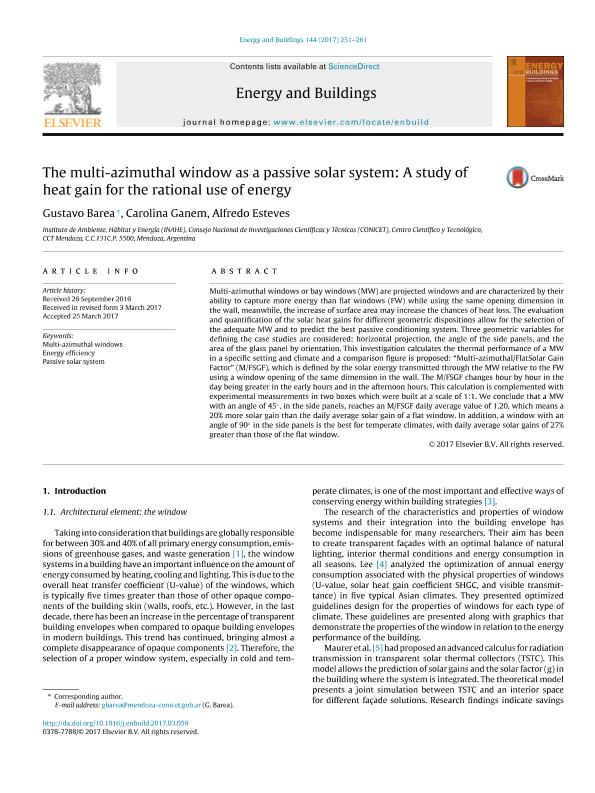Mostrar el registro sencillo del ítem
dc.contributor.author
Barea Paci, Gustavo Javier

dc.contributor.author
Ganem, Carolina

dc.contributor.author
Esteves Miramont, Alfredo

dc.date.available
2018-03-27T16:38:44Z
dc.date.issued
2017-06
dc.identifier.citation
Barea Paci, Gustavo Javier; Ganem, Carolina; Esteves Miramont, Alfredo; The multi-azimuthal window as a passive solar system: A study of heat gain for the rational use of energy; Elsevier Science Sa; Energy and Buildings; 144; 6-2017; 251-261
dc.identifier.issn
0378-7788
dc.identifier.uri
http://hdl.handle.net/11336/40163
dc.description.abstract
Multi-azimuthal windows or bay windows (MW) are projected windows and are characterized by their ability to capture more energy than flat windows (FW) while using the same opening dimension in the wall, meanwhile, the increase of surface area may increase the chances of heat loss. The evaluation and quantification of the solar heat gains for different geometric dispositions allow for the selection of the adequate MW and to predict the best passive conditioning system. Three geometric variables for defining the case studies are considered: horizontal projection, the angle of the side panels, and the area of the glass panel by orientation. This investigation calculates the thermal performance of a MW in a specific setting and climate and a comparison figure is proposed: “Multi-azimuthal/FlatSolar Gain Factor” (M/FSGF), which is defined by the solar energy transmitted through the MW relative to the FW using a window opening of the same dimension in the wall. The M/FSGF changes hour by hour in the day being greater in the early hours and in the afternoon hours. This calculation is complemented with experimental measurements in two boxes which were built at a scale of 1:1. We conclude that a MW with an angle of 45°, in the side panels, reaches an M/FSGF daily average value of 1.20, which means a 20% more solar gain than the daily average solar gain of a flat window. In addition, a window with an angle of 90° in the side panels is the best for temperate climates, with daily average solar gains of 27% greater than those of the flat window.
dc.format
application/pdf
dc.language.iso
eng
dc.publisher
Elsevier Science Sa

dc.rights
info:eu-repo/semantics/openAccess
dc.rights.uri
https://creativecommons.org/licenses/by-nc-sa/2.5/ar/
dc.subject
Energy Efficiency
dc.subject
Multi-Azimuthal Windows
dc.subject
Passive Solar System
dc.subject.classification
Otras Artes

dc.subject.classification
Arte

dc.subject.classification
HUMANIDADES

dc.title
The multi-azimuthal window as a passive solar system: A study of heat gain for the rational use of energy
dc.type
info:eu-repo/semantics/article
dc.type
info:ar-repo/semantics/artículo
dc.type
info:eu-repo/semantics/publishedVersion
dc.date.updated
2018-03-27T13:38:56Z
dc.journal.volume
144
dc.journal.pagination
251-261
dc.journal.pais
Países Bajos

dc.journal.ciudad
Amsterdam
dc.description.fil
Fil: Barea Paci, Gustavo Javier. Consejo Nacional de Investigaciones Científicas y Técnicas. Centro Científico Tecnológico Conicet - Mendoza. Instituto de Ambiente, Hábitat y Energía; Argentina
dc.description.fil
Fil: Ganem, Carolina. Consejo Nacional de Investigaciones Científicas y Técnicas. Centro Científico Tecnológico Conicet - Mendoza. Instituto de Ambiente, Hábitat y Energía; Argentina
dc.description.fil
Fil: Esteves Miramont, Alfredo. Consejo Nacional de Investigaciones Científicas y Técnicas. Centro Científico Tecnológico Conicet - Mendoza. Instituto de Ambiente, Hábitat y Energía; Argentina
dc.journal.title
Energy and Buildings

dc.relation.alternativeid
info:eu-repo/semantics/altIdentifier/doi/http://dx.doi.org/10.1016/j.enbuild.2017.03.059
dc.relation.alternativeid
info:eu-repo/semantics/altIdentifier/url/https://www.sciencedirect.com/science/article/pii/S0378778816309720
Archivos asociados
